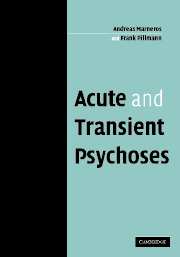Book contents
- Frontmatter
- Contents
- Preface
- Acknowledgements
- Part I History and concepts
- Part II Studies and findings
- 3 Studies on brief and acute psychoses
- 4 Frequency and sociobiographic characteristics of acute and transient psychotic disorders (ATPD) and brief psychoses (BP)
- 5 The clinical features of the acute episode
- 6 Treatment
- 7 The longitudinal course
- 8 The long-term outcome
- 9 Suicidal behaviour
- 10 Comorbidity and somatic findings
- Part III Issues of nosology
- References
- Index
10 - Comorbidity and somatic findings
from Part II - Studies and findings
Published online by Cambridge University Press: 07 August 2009
- Frontmatter
- Contents
- Preface
- Acknowledgements
- Part I History and concepts
- Part II Studies and findings
- 3 Studies on brief and acute psychoses
- 4 Frequency and sociobiographic characteristics of acute and transient psychotic disorders (ATPD) and brief psychoses (BP)
- 5 The clinical features of the acute episode
- 6 Treatment
- 7 The longitudinal course
- 8 The long-term outcome
- 9 Suicidal behaviour
- 10 Comorbidity and somatic findings
- Part III Issues of nosology
- References
- Index
Summary
ATPD, by definition, are functional psychoses. A diagnosis of an organic psychosis or any other kind of organic mental disorder is not compatible with ATPD. Nevertheless, an ‘organic impression’ of the symptomatology is not uncommon in ATPD, and may include features such as confusion or disorientation (Murai et al., 1996). A number of authors have suggested that metabolic, endocrinological or epileptic mechanisms play a role in the pathogenesis of Brief and Acute Psychoses (Kleist, 1953; Monroe, 1959; Kurosawa, 1961; Fekkes et al., 1994; Hatotani, 1996). Investigations carried out in India identified antecedent fever as a risk factor for the occurrence of Acute Brief Psychosis (Collins et al., 1996, 1999; Malhotra et al., 1998). In order to investigate the role of somatic illness in ATPD, somatic diagnoses and paraclinical findings in ATPD are reported and compared to PS and ATPD.
Somatic comorbidity
Somatic comorbidity in the three diagnostic groups is reported in Table 10.1. This includes all somatic diagnoses that were documented during the acute episode or elicited in the sociobiographic interview, irrespective of a possible etiological link to the psychiatric disorder. There was no significant difference between the three diagnostic groups in somatic comorbidity. The diagnoses covered the whole spectrum of medicine and different degrees of severity. In Table 10.2, the prevalence of diagnoses in diagnostic categories of particular relevance is reported (neurological, endocrinological and cardiovascular). No particular pattern of comorbid diagnoses was observed.
- Type
- Chapter
- Information
- Acute and Transient Psychoses , pp. 162 - 170Publisher: Cambridge University PressPrint publication year: 2004



